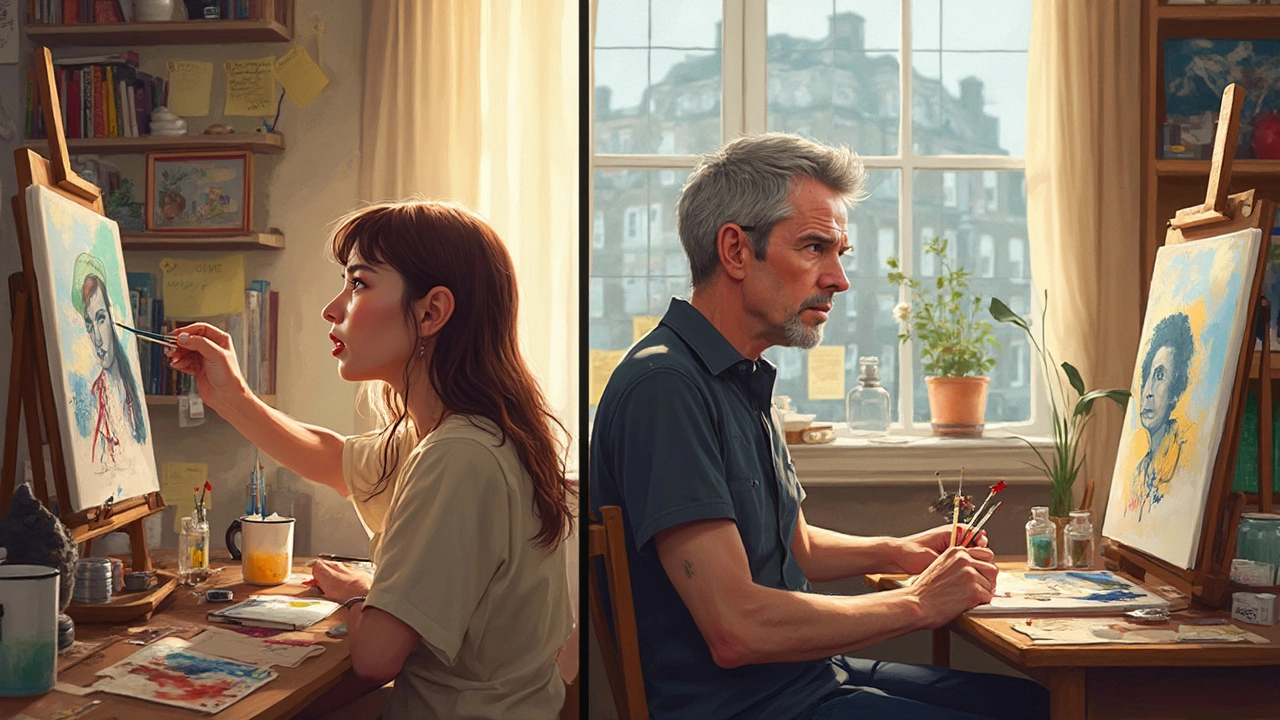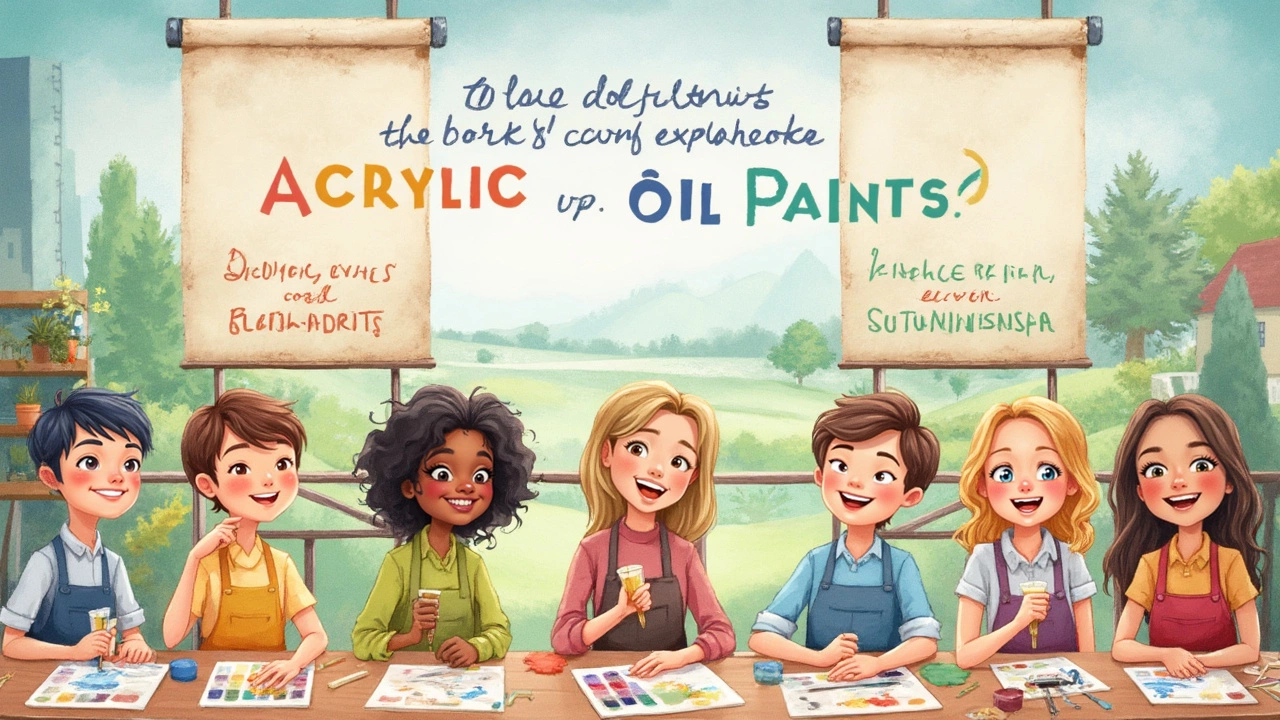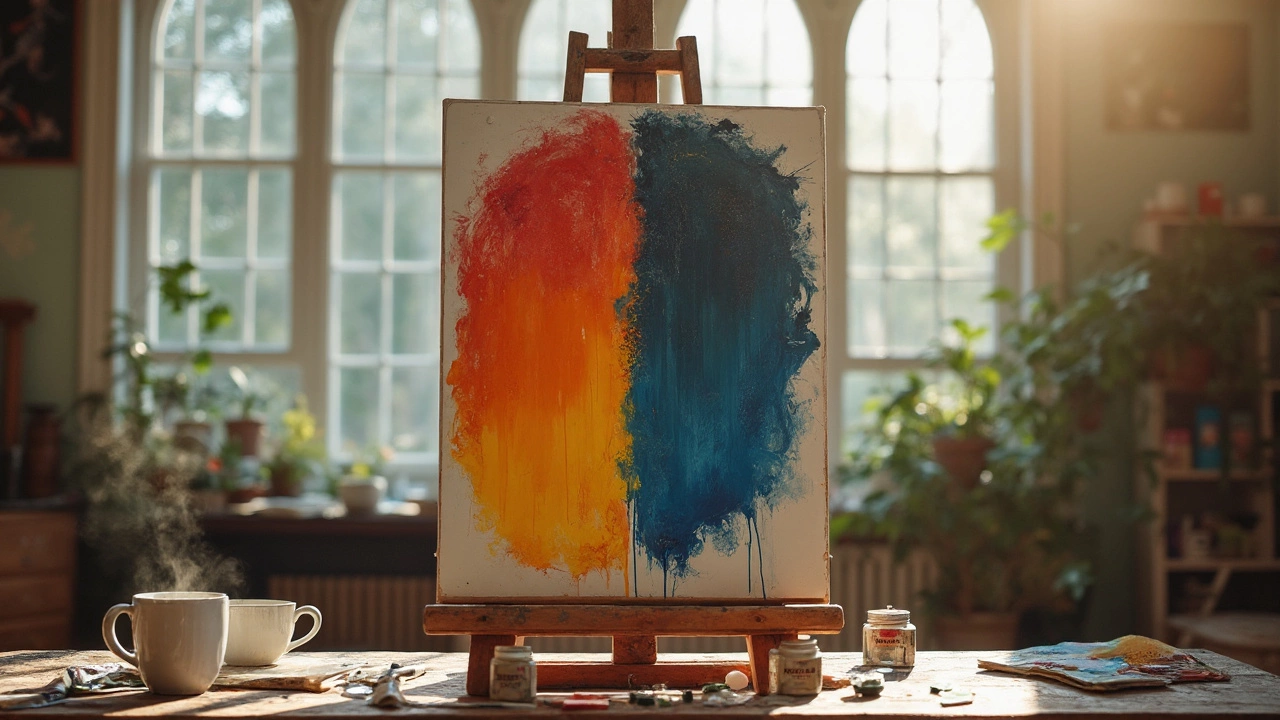Ever stared at a blank canvas, unsure whether to go with acrylics or oils? It’s a classic dilemma, especially when you want your portrait to actually look like the person, not some abstract blur. The truth is, each paint type has its own quirks. Acrylic dries in what feels like seconds, so you’re racing the clock. Oil, on the other hand, lets you blend and tweak everything for hours—or even days. No wonder beginners are torn.
If you hate cleaning up with strong-smelling stuff, acrylics win—just wash your brushes in water and you’re done. Oils, though, will make your studio smell like a hardware store, thanks to all those solvents. Here’s a wild fact: some pros actually use acrylics underneath their oils to speed things up and avoid the boring waiting game.
Don’t just pick what sounds easier. Think about how you paint, how much patience you have, and when you want your painting finished. There’s no universal answer—but there’s definitely a best choice for you. We’re about to break down the biggest differences, bust a few myths, and share some tricks you can actually use.
- Quick Facts: Acrylic and Oil Paint
- How Handling and Drying Time Affect Portraits
- Blending and Layering: Pros and Cons
- Cleanup, Safety, and Costs
- Tips for Picking the Right Paint for You
Quick Facts: Acrylic and Oil Paint
If you’re tackling a portrait, it helps to have the lowdown on what you’re working with. Here’s a straight-up comparison between acrylics and oils so you’re not guessing at the store.
| Feature | Acrylic Paint | Oil Paint |
|---|---|---|
| Drying Time | 10-30 minutes (can’t rework after it dries) | 6 hours to several days (keeps blending longer) |
| Cleanup | Plain water | Needs solvents (like turpentine or mineral spirits) |
| Finish | Dries a bit darker and flatter | Has a richer, glossier look |
| Layering | Fast layers, but can pull up old paint if not dry | Can layer or blend for hours as it dries slowly |
| Longevity | Very stable if stored right, but can fade in super bright light over decades | Masterpieces have lasted centuries in museums |
| Cost (starter set) | About $15–$30 | About $25–$50 |
Here’s something you’ll notice fast: acrylic paint is all about speed. You can put down a base coat, have coffee, and come back already dry. Oil takes its time—but that’s why you see those soft blends in old portraits.
- Acrylics don’t smell, and they won’t wreck your brushes if you forget to clean them for an hour.
- Oils need a commit-to-the-process mindset. The smell is stronger, but tons of artists love the control they offer.
- The acrylic painting technique is really forgiving if you want to make quick changes or try new things before things set.
- Oil paintings hold their color longer—think about all those classic portraits in museums still looking fresh.
If you worry about mistakes, acrylics let you paint over a misstep in minutes. Oils, though, give more time for blending, but you’ll need patience when waiting for things to dry.
How Handling and Drying Time Affect Portraits
The biggest practical difference between acrylic and oil paint comes down to how quickly they dry. If you’re trying to nail a portrait that shows off smooth skin, subtle shading, or tiny highlights, this matters a lot. Acrylic paint dries super fast—sometimes within ten minutes, especially in warm rooms. Oil paint can take anywhere from several hours to a few days to dry to the touch. Some thick spots might stay tacky for a week.
If you make a mistake with acrylic painting, you need to fix it before the paint sets, or you’ll have to paint over it completely. With oil, you can blend, push, and move colors around for much longer. This longer “open time” lets you blend skin tones right on the canvas, making it easier to get smooth transitions and realistic effects—if you like taking your time.
| Paint Type | Drying Time | Blending Window |
|---|---|---|
| Acrylic | 5–30 mins | 1–15 mins |
| Oil | 6 hrs–7 days | 2–48 hrs |
Fast drying with acrylics can be both a blessing and a curse. If you want crisp edges and sharp details, it lets you layer quickly. But if you need soft color changes or subtle blends, the pace can frustrate you. Some artists try acrylic retarders (a type of gel) to slow things down, giving you a bit more time to blend—but it’s still not like painting with oil.
Oils suit patient artists who want to work on a portrait over a few days, maybe going back to fix a nose or tweak a jawline. That said, because they don’t dry quickly, you can accidentally smudge areas you thought were finished—so don’t rest your hand on the wet canvas!
The bottom line: if you want speed and less waiting, acrylics are the fastest ticket, but for more forgiving blending and fixes, oil lets you take your time. Knowing how both handle can save you from a ton of headaches when painting portraits.

Blending and Layering: Pros and Cons
Here’s where things get real for portrait painters: if you want smooth skin and subtle shadows, blending and layering will make or break your work. This step can get messy fast if you don’t know what your paint can do.
The biggest advantage of oil painting is how slowly it dries. That slow dry time lets you push and pull the paint, feathering edges and mixing colors right on your canvas. You see those classic portraits with dreamy, soft transitions between highlights and shadows? Nine times out of ten, oil paints did the job. Some artists even work on a single layer for days, adjusting colors until the face looks just right.
Acrylics are a different beast. They dry fast—sometimes too fast—so your window for blending is pretty short. That can get stressful if you like to fuss over every angle of a cheekbone. Acrylics tend to look chunkier and more graphic unless you work in smaller sections or use special slow-dry mediums. Want to keep your edges soft? Mist your canvas, or mix a slow-drying gel into your paint. Some folks even pre-mix their blends on the palette so they can work faster before the paint gets tacky.
- Oil pros: Blends for days, lets you work wet-on-wet, ideal for realism. You can stack layers on top of each other without muddying the colors if you let each one dry properly.
- Oil cons: Takes forever to dry between layers. You might mess up work you did days ago if you’re not careful, and you’ll need patience to let each stage set.
- Acrylic pros: Quick to layer up, so you can build depth fast. Mistakes dry almost instantly, so you don’t usually smudge finished areas.
- Acrylic cons: Tricky to blend large areas before the paint dries. Plus, if you try to layer too quickly before the base is fully dry, you might lift paint right off the canvas.
Want a pro tip? If you want the best of both worlds, try the "acrylic underpainting" method: block in your values and colors with acrylic, then add finishing touches with oils on top. Tons of experienced artists swear by this combo.
Cleanup, Safety, and Costs
If mess drives you crazy or you’re painting in a small space, you’ll want to know the real differences in cleaning up acrylic versus oil paint. With acrylics, it’s as simple as rinsing your brushes in water—no weird chemicals, just soap and a sink. For oil painting, it’s a whole other story. You need solvents like turpentine or mineral spirits to get brushes clean, and those fumes aren’t friendly. In fact, working with oils indoors means cracking open a window or using a fan to keep irritation and headaches away.
Safety matters, especially if you paint around pets or kids. Acrylic paint is generally pretty harmless when used normally and doesn’t stink up your studio. Oil paints and their solvents, though, include stuff that can really irritate your skin and lungs. Some oil colors even have heavy metals, so gloves aren’t a bad idea. Always check the label—if you see words like “cadmium” or “cobalt,” don’t lick your brush (seriously, some artists do).
Now for the part that hits your wallet. Here’s a quick breakdown:
| Item | Acrylic | Oil |
|---|---|---|
| Paint (starter set, 12 colors, 20ml) | $15–$30 | $20–$60 |
| Brush cleaner/solvents | $0 (water) | $8–$15 |
| Varnish/medium | $6–$15 | $10–$30 |
| Surface prep (gesso or primer) | $10 (optional) | $10 (usually needed) |
Starting with acrylics is clearly cheaper. Plus, you won’t annoy your family or roommates with toxic smells. But if you don’t mind the extra steps and want that classic oil-paint look, the price bump might be worth it. Remember, cleanup and safety can change how often you actually want to paint. If it feels like a chore, even the best paint won’t help you stick with it.
- Always clean up spills right away, especially with oil paint.
- Keep windows open when using solvents.
- Soap and water are your acrylic cleanup buddies. For oils, brushes last longer if you wash them with brush soap after using solvent.
- Store leftover paint safely, out of reach of pets and little hands.
You don’t need to go broke or turn your house into a chemistry lab—just pick what fits your setup. For most beginners or anyone allergic to effort, acrylic is the hassle-free winner. But for old-school purists, the oil routine is just part of the hobby.

Tips for Picking the Right Paint for You
Choosing between acrylic and oil for portrait painting isn’t about picking the “superior” material. It’s about what actually works for your lifestyle, skill level, and goals. Let’s keep it practical.
If you need fast results or paint in a shared space, acrylic makes sense. It dries in 15 to 30 minutes, so you can do multiple layers in one afternoon—great for anyone who likes finishing a project in a single weekend. Oil paint, though, gives you all the time in the world to really work those skin tones and subtle shading, but you’ll wait days before it’s dry enough for the next step. Here’s a side-by-side of some of the most practical differences:
| Feature | Acrylic | Oil |
|---|---|---|
| Drying time | 15–30 minutes (thin) | 2–5 days (touch dry) |
| Cleanup | Water | Solvent (turpentine/mineral spirits) |
| Blending | Challenging, dries fast | Easy, long open time |
| Odor | Minimal | Strong (need ventilation) |
| Cost (starter set) | $15–$30 | $25–$60 |
For beginners, acrylic can be less intimidating. You can paint in your bedroom, skip the toxic fumes, and just use a cheap plastic palette. Oils require more setup and patience, but if you crave that extra-smooth blending—think Renaissance-style skin—you’ll get frustrated with fast-drying paint.
- Think about your workspace. If you share a home or have pets, acrylic is way safer.
- Do you want to finish quickly? Acrylic wins by a mile.
- If you love soft, gradual shading and aren’t in a hurry, try oils. Switching to slow-dry acrylic mediums is another option, but it still isn’t quite the same as oil for those creamy blends.
- Budget matters too. Acrylics are cheaper to start with—just paint, brushes, water, and a surface. Oils cost more after you add up paints, solvents, and special brushes.
- Allergies or sensitivity to smells? Oil painting can trigger headaches or skin irritation, so test it before buying a whole set.
There’s really no rule that says you have to pick one forever. Tons of artists switch back and forth, or even use both in the same piece. If you’re serious about acrylic painting or oil painting, try a tiny portrait with each, side by side. You’ll instantly see which one fits you best, and you might surprise yourself.

